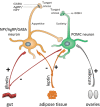Minireview: Metabolism of female reproduction: regulatory mechanisms and clinical implications
- PMID: 24678733
- PMCID: PMC4042071
- DOI: 10.1210/me.2013-1413
Minireview: Metabolism of female reproduction: regulatory mechanisms and clinical implications
Abstract
Female fertility is highly dependent on successful regulation of energy metabolism. Central processes in the hypothalamus monitor the metabolic state of the organism and, together with metabolic hormones, drive the peripheral availability of energy for cellular functions. In the ovary, the oocyte and neighboring somatic cells of the follicle work in unison to achieve successful metabolism of carbohydrates, amino acids, and lipids. Metabolic disturbances such as anorexia nervosa, obesity, and diabetes mellitus have clinically important consequences on human reproduction. In this article, we review the metabolic determinants of female reproduction and their role in infertility.
Figures



References
-
- Dietrich MO, Horvath TL. Feeding signals and brain circuitry. Eur J Neurosci. 2009;30(9):1688–1696 - PubMed
-
- Horvath TL, Bechmann I, Naftolin F, Kalra SP, Leranth C. Heterogeneity in the neuropeptide Y-containing neurons of the rat arcuate nucleus: GABAergic and non-GABAergic subpopulations. Brain Res. 1997;756(1–2):283–286 - PubMed
-
- Ollmann MM, Wilson BD, Yang YK, et al. Antagonism of central melanocortin receptors in vitro and in vivo by agouti-related protein. Science. 1997;278(5335):135–138 - PubMed
-
- Chen HY, Trumbauer ME, Chen AS, et al. Orexigenic action of peripheral ghrelin is mediated by neuropeptide Y and agouti-related protein. Endocrinology. 2004;145(6):2607–2612 - PubMed
Publication types
MeSH terms
Grants and funding
LinkOut - more resources
Full Text Sources
Other Literature Sources
Medical

